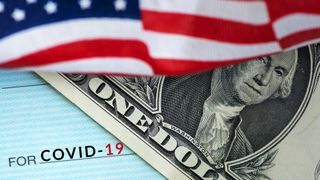Stimulus checks: Here's which states are sending out money [updated]
Nearly a dozen states are distributing their own stimulus payments

While federal initiatives to create additional or ongoing federal stimulus checks don't appear to have much momentum in Washington, D.C., some Americans are still receiving stimulus relief from their state governments — and not only those who are unemployed.
A handful of states have sent (or are planning to send) bonuses to teachers and other essential workers as a form of "hazard pay" to attract and retain people in these difficult jobs. In other states, extra funds are being distributed to low-income and middle-class families. Here's a rundown of who is getting what and where.
- Fourth stimulus check: Are more payments coming?
- Here's how to make sure you get your next stimulus check
- Plus: Millions to get more stimulus payments this week
California
Thanks to a budget surplus, nearly two-thirds of Californians are receiving relief known as the Golden State Stimulus I and II. Payments total anywhere from $500 to $1,200, depending on eligibility and payment round.
California recently expanded the stimulus program to include middle-class families, and checks from this expansion are now being sent out, as of early September 2021.
Colorado
Colorado residents who claimed unemployment benefits between $25 and $500 for any week between March 15, 2020 and Oct. 24, 2020 also got a one-time stimulus payment totaling $375. Those eligible have already received this benefit, as the program began last December and has now concluded.
Florida
First responders and educators in Florida are receiving one-time, $1,000 bonuses using funding from the Biden administration's American Rescue Plan. The first wave of payments went out to firefighters, law enforcement officers, EMTs and paramedics, while a second round will be going to teachers and school principals.
While there was some initial controversy around the payout plan, Gov. Ron DeSantis has said he expects payments to be distributed mid-August.
Sign up to get the BEST of Tom’s Guide direct to your inbox.
Upgrade your life with a daily dose of the biggest tech news, lifestyle hacks and our curated analysis. Be the first to know about cutting-edge gadgets and the hottest deals.
Georgia
Educators and school staff in Georgia are getting retention bonuses of $500 (for part-time workers) or $1000 (for full-time employees). Eligible groups include teachers, principals, mental-health and medical professionals, and other support staff: custodians, bus drivers, media specialists, clerical staff and administrative assistants.
Maryland
Low-income earners in Maryland received state stimulus payments of either $300 or $500 earlier this year. To qualify, taxpayers had to claim the earned-income tax credit on their 2019 state returns. Maryland also distributed $1,000 checks to people who had difficulty accessing unemployment benefits.
Michigan
Michigan sent so-called hazard pay to teachers and school staff earlier this year. Checks totaled $500 and $250, respectively. Recipients must have worked 75% of the 2019–2020 school year to qualify, and neither administrators nor private, denominational or parochial-school staff were eligible.
In Detroit, the local school district is giving teachers another round of hazard pay totaling $2,000 over the course of the 2021-22 school year.
New Mexico
A handful of low-income households in New Mexico received one-time, $750 payments this summer as part of an emergency financial assistance program for those who did not receive a federal stimulus check. More than 6,300 people applied for aid, which was granted to 4,631 households.
Tennessee
Tennessee's state legislature approved $1,000 bonuses for K-12 teachers in lieu of a 2% raise that was originally proposed.
Texas
A handful of school districts in Texas are distributing pay raises and cash incentives for teachers and school employees.
Those in Fort Worth and Arlington are getting a 4% bump, while those in Denton and Mansfield are getting an additional 2%. Plus, teachers and staff in Denton will get a $500 retention bonus, and those in Irving will get $2,000.
- More: How to freeze your credit: Everything you need to know
- How to freeze your credit with Equifax
- How to freeze your credit with Experian
- How to freeze your credit with TransUnion
Emily Long is a Utah-based freelance writer who covers consumer technology, privacy and personal finance for Tom's Guide. She has been reporting and writing for nearly 10 years, and her work has appeared in Wirecutter, Lifehacker, NBC BETTER and CN Traveler, among others. When she's not working, you can find her trail running, teaching and practicing yoga, or studying for grad school — all fueled by coffee, obviously.
Most Popular


